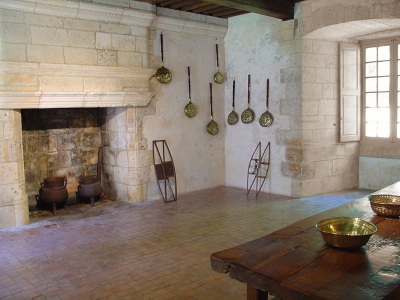-
History of:
- Resources about:
- More:
- Baby walkers
- Bakehouses
- Bed warmers
- Beer, ale mullers
- Besoms, broom-making
- Box, cabinet, and press beds
- Butter crocks, coolers
- Candle snuffers, tallow
- Clothes horses, airers
- Cooking on a peat fire
- Drying grounds
- Enamel cookware
- Fireplaces
- Irons for frills & ruffles
- Knitting sheaths, belts
- Laundry starch
- Log cabin beds
- Lye and chamber-lye
- Mangles
- Marseilles quilts
- Medieval beds
- Rag rugs
- Rushlights, dips & nips
- Straw mattresses
- Sugar cutters - nips & tongs
- Tablecloths
- Tinderboxes
- Washing bats and beetles
- Washing dollies
- List of all articles
Subscribe to RSS feed or get email updates.
...the warming pan...spoke as follows:
"I pass over my early life. Time was when I was thought much of in this family. Early in the autumn, I was rubbed and polished till you could see your face in me. On the first cold night, some nice walnut wood embers were carefully put into me; I had the pleasure and honor of being passed up and down my mistress's bed till it was well warmed, and this service I performed for her constantly till the warm weather returned. When any one in the family was ill, I was employed on the same service for him or her; or when guests came to pass the night, I performed this office for them...
After my master's and mistress's death, I was sent up to the garret to be put among the useless old things, such as gentlemen's broadswords, broken pitchers, noseless tea-kettles, etc. The reason for this is not that I am worn out, but because the age is so much wiser that they have come to the conclusion that cold beds are more healthy than warm ones...
Eliza Lee Cabot Follen, Who Spoke Next (Boston, mid-19th century)
Put off your cloathes in Winter by the fire side: and cause your bed to be heated with a warming pan: unlesse your pretence be to harden your members, and to apply your selfe unto militarie discipline. This outward heating doth wonderfully comfort the inward heat, it helpeth concoction, and consumeth moisture.
William Vaughan, Approved Directions for Health, 1612
Bed warmers
Warming pans: heating the bed with embers from the fire
 Hanging a warming pan near the hearth
is not just a decorator's idea. The fireplace was always a sensible place for it,
so it could easily be filled with glowing coals or wood embers before being taken
away to warm the bed.
Hanging a warming pan near the hearth
is not just a decorator's idea. The fireplace was always a sensible place for it,
so it could easily be filled with glowing coals or wood embers before being taken
away to warm the bed.
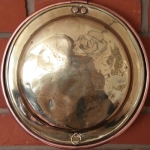 Using a hot stone or brick heated at the fireside is one way of carrying warmth
from the hearth into bed. By the 16th century people were also taking pans filled
with smouldering fuel from the fire itself. The well-known brass or copper warming
pan on a handle was not the only way of doing this. There were also wooden frames
designed to hold pots of fuel inside the bedclothes. (See lower down the page)
Using a hot stone or brick heated at the fireside is one way of carrying warmth
from the hearth into bed. By the 16th century people were also taking pans filled
with smouldering fuel from the fire itself. The well-known brass or copper warming
pan on a handle was not the only way of doing this. There were also wooden frames
designed to hold pots of fuel inside the bedclothes. (See lower down the page)
A warming pan, sometimes known as a bed warmer nowadays, was a valuable family possession handed down from generation to generation, but not so expensive that it was only for the rich. If you were very wealthy you might have a silver one, or a richly decorated copper warmer. Some of the most ornate warming pans have an elaborate pattern of perforations incorporated in the design.
But not all warming pans had pierced patterns. This difference would have been crucial for the servant or housewife using the pan. With air holes, the embers would keep smouldering, the heat would last longer, but the bed would probably smell of fumes and there was an increased risk of scorching the sheets. The smell was not always of wood or coal; in some parts of the UK it was burning peat.
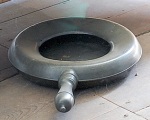 In 19th-century England fully
enclosed warming pans seem to have been popular: cleaner perhaps, but the heat would
have died down more quickly. Some warming-pans with solid lids were used with hot
water. Others were completely open like this
unlidded warming pan from the French Alps.
In 19th-century England fully
enclosed warming pans seem to have been popular: cleaner perhaps, but the heat would
have died down more quickly. Some warming-pans with solid lids were used with hot
water. Others were completely open like this
unlidded warming pan from the French Alps.
Warming pans on a handle were designed for moving up and down the bed before someone got into it. The handle wasn't always lined up to make it easy to hang on the wall. Some warmers, in Italy or southern France, for instance, were more saucepan-shaped.
A copper warming pan is indispensable to a household. Take care to have a big enough quantity of embers, above all some red cinders, when you want to heat a bed. Get it smouldering well before you use it, otherwise the fire will soon go out and the bed will not warm up. You must move the warming pan constantly to avoid scorching the sheets. A bed-wagon (moine), well-known and inexpensive, is a suitable alternative.
Cora Millet-Robinet, Domestic Economy, 1853 (translated loosely from the French)
Frames to hold pots of coals: bed wagons
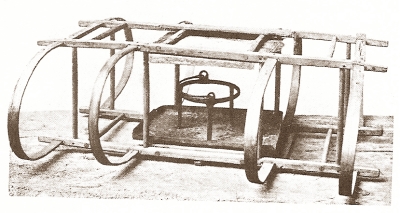 If you didn't want to stand in a cold bedroom moving the warming pan up and down,
you might possibly have a bed wagon. This was a large frame designed to hold a pot
of glowing fuel in the centre of the bed. The one in the photograph is shaped like
other bed wagons
from southern England, but made of oak, rather than the more common ash.
If you didn't want to stand in a cold bedroom moving the warming pan up and down,
you might possibly have a bed wagon. This was a large frame designed to hold a pot
of glowing fuel in the centre of the bed. The one in the photograph is shaped like
other bed wagons
from southern England, but made of oak, rather than the more common ash.
An odd-looking contrivance, generally in use in farms in the olden days, was the bed-waggon. It is used for warming a large bed, and must have done its work most efficiently. The one shown [see photo] is three feet long, but they were generally larger. The woodwork is all of oak, the bent hoops passing through the straight rails, which are tied together with round rods. The whole thing is light and strong. A pan of hot embers drops into the trivet, which stands on a sheet-iron tray. Another sheet of iron is fixed under the woodwork above the fire, so that there is no danger of burning the bed.
Gertrude Jekyll, Old West Surrey, 1904
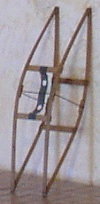 The equivalent in
Italy and France looked more like a sledge than a wagon: a sledge
carrying a pot of glowing charcoal or wood, sometimes hanging from the top of the
frame. This pot could be iron, brass or even earthenware, lidded or unlidded. Unlidded
pots might be given a layer of ashes over the fuel. Italian and French bed-wagon
frames are traditionally called a monk (moine or monaco) or a
priest. Presumably there's some kind of people-in-bed humour there, in the same
vein as the English joke about a housemaid being a "Scotch warming pan". Explanations
vary.
The equivalent in
Italy and France looked more like a sledge than a wagon: a sledge
carrying a pot of glowing charcoal or wood, sometimes hanging from the top of the
frame. This pot could be iron, brass or even earthenware, lidded or unlidded. Unlidded
pots might be given a layer of ashes over the fuel. Italian and French bed-wagon
frames are traditionally called a monk (moine or monaco) or a
priest. Presumably there's some kind of people-in-bed humour there, in the same
vein as the English joke about a housemaid being a "Scotch warming pan". Explanations
vary.
The photo left shows one moine propped up by the wall, and the one below shows it with another moine and an assortment of warming pans near a big kitchen fireplace in a French castlet: the Chateau de Puyguilhem in the Dordogne.
When Charles Dickens' character Mr. Pickwick called a long-handled brass warming-pan "a useful, and...a comforting article of domestic furniture", he touched on all the snug cosiness we associate with being tucked up in a warm bed. Not everyone approves of warm, comfortable beds, though. Rather like those people who criticised warm feather beds, one 18th century doctor disliked warming pans, though he thought hot sand was a helpful alternative to embers for anyone who could not bear a cold bed:
People in health ought never to have their beds warmed; not only because the fumes of the coals are in some degree noxious, but because warmth thus applied enervates the body. [...] If, however, invalids and sick persons cannot from custom dispense with bed warming, one or two quarts of sand, made red hot in an iron pot, and put into the warming pan, will be void of all offensive smell.....
Dr. James Makittrick Adair, Essays on Fashionable Diseases: the dangerous effects of hot and crowded rooms, c1790
- More on beds:
- Featherbeds
- Box beds
- Straw mattresses
- One-legged beds
- Medieval beds - with glossary
- Warming the bed
- Also see:
- Hand Warmers
- Foot warmers
 31 October 2007 (updated June 2011)
31 October 2007 (updated June 2011)
You may like our new sister site Home Things Past where you'll find articles about antiques, vintage kitchen stuff, crafts, and other things to do with home life in the past. There's space for comments and discussion too. Please do take a look and add your thoughts. (Comments don't appear instantly.)
For sources please refer to the books page, and/or the excerpts quoted on the pages of this website, and note that many links lead to museum sites. Feel free to ask if you're looking for a specific reference - feedback is always welcome anyway. Unfortunately, it's not possible to help you with queries about prices or valuation.


